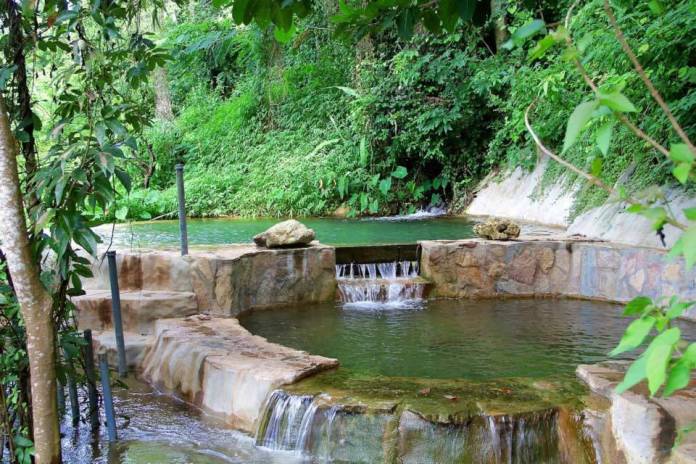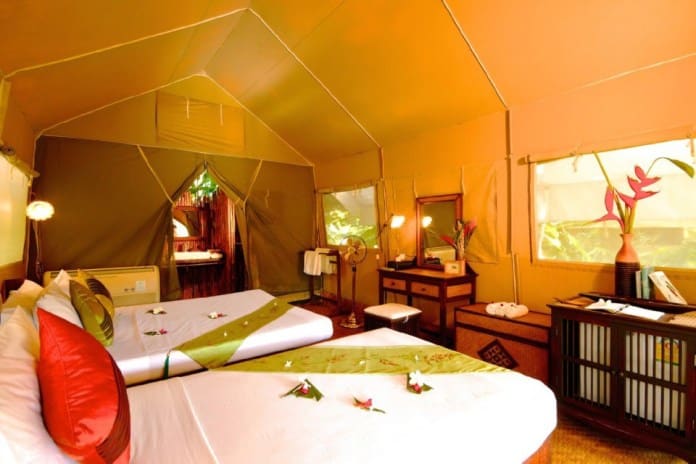Glamping in Kanchanaburi, Thailand
Author : Merel Nahuijsen

Lip gloss, long hair and wind are not a good combination. Holding on to the railing of the boat on the Kwai river, I try to keep my long hair out of my face. Why on earth did I apply lip gloss this morning? And why did I leave my hair clip in the tent…?
Tent? Yes, tent! My kids and hubby love camping and they’d finally convinced me to come with them. Being a fan of nice resorts with big, comfortable beds, it took them a great deal to drag me to this camping ground in Thailand. But here I am. Ready or not, for four nights of camping in the bush.
Sai Yok National Park
We’re in the province of Kanchanaburi, north-west of Bangkok, Thailand’s capital and close to the border with Myanmar. Since Kanchanaburi is slightly elevated, it is a bit cooler than in the stuffy capital. This region with its many mountains and caves, steep cliffs, waterfalls and slow meandering rivers make it ideal for walking, canoeing and mountain biking.
In Sai Yok National Park in Kanchanaburi you can do this at your heart’s content. On the way up from Bangkok, we see signs which advertise for elephant rides. Because this is bad for the elephants backs and in general not a good idea, we decide to opt for more eco-friendly activities. Apparently, however, Kanchanaburi does have two ethical elephant parks. One of the them, the Elephant Haven is small and run under the umbrella of Elephant Nature Park in Chiang Mai.

Hellfire Pass
Sai Yok National Park is a region with a history; in 1942 many Australian, Dutch and British prisoners of war and romushas (Asian workers who were forced to work or for a very low salary) worked on the infamous 415 km long Burma Railway.
The part of the railway which was built in the Tenasserim hills was most challenging, because it was the largest rock cutting on the railway. Workers had only simple tools, like hammers and dynamite. Even though they were forced to work 18 hours per day, it took them almost 12 weeks to create the 125 meter long pass through the hill. Many of them died from beatings by the Japanese, or diseases like cholera and dysentery or from exhaustion.

After World War II this part of the track was renamed: Hellfire Pass seemed a suitable name for the place where torches by night lit the labourers and cast shadows on the stone walls. We decided to visit this impressive place together with our two children, who were particularly intrigued by the many small holes in the rocks where unexploded dynamite had been places. Don’t worry, it’s long gone now.
Old iron plates with inscriptions for those who hadn’t survived the atrocities committed in Hellfire Pass decorate the rocks. Not much is left of the timber railway which was built here 70 years ago.

However, you can still take a train from Nam Tok Sai Yok station, which we did. A truly memorable trip which the kids enjoyed very much. The views over the river Kwai are breathtaking. I did not care for the timber seats though… The trip doesn’t take that long and therefore is very suitable for children, even the youngest.

Hintok River Camp
For those unfamiliar with the word ‘glamping’: it’s a combination of the words ‘camping’ and ‘glam’. And yes indeed, we arrive at Hintok River Camp and our tent is already set up. To my delight, the tent has got real beds, which feel surprisingly comfortable, and also a fridge, a toilet and shower, air-conditioning and the veranda in front is absolutely wonderful. Well, if this is camping, I don’t mind at all! The kids were excited to sleep in the tents in the middle of nature. It turned out there was no need for the aircons, since it cools down a lot during the evening.

Hintok River Camp is located next to River Kwai (yes, from the famous book and movie The Bridge over River Kwai). The next day we take the kids to the river and make a mini cruise to the nearby Lawa cave. Tip for city chicks: no need for lip gloss, so best to leave behind in the tent.

After the cave visit we take the kids to the natural swimming pool, a place with amazing views over the river. Be careful with little ones: some stones are a bit slippery.
Next to the camping site there is a small village with the name Had Ngew. We take the kids to look around on bikes from the camp. The Buddha temple close by is great as well and also the hanging bridge. Nice to know: Hintok River camp sponsors the small village by building a school and developing a water sanitation programme.

Underneath the stars
Breakfast is quite basic but healthy and plenty. The evenings are spend in the central area, with a superb BBQ (meat and fish), fantastic Thai salads made on the spots (don’t forget to ask for non-spicy if your kids are not into it) and a great camp fire with marsh mellows. This reminds me of my youth when we camped out with our scouts team. And after that, what could be more amazing than falling asleep underneath a thousand stars, with the sound of cicadas in the background. Raatrie sawat ka… Sleep well…

To do:
- Attend the central campfire each night
- Cuddle with the camping sheep – these woolly friends work at the camp to keep the grounds tidy.
- Lots of cool activities like canoeing, visiting the cave and riding the train on the original historical train track
Be mindful:
- Historical part of Kanchanaburi may not be suitable/ interesting for all ages
- Some activities require a good level of swimming
- The Thai kitchen is famous for its spicy food; some small ones might not be used to it
Best time to visit Kanchanaburi
The region is a year round destination, but can be extremely hot from April till June. July till October brings more rain. From November till February temperatures are more moderate, so this is an excellent time of the year to visit!
How to get there
Airasia and Malindo fly 14 times a day from Kuala Lumpur to Bangkok. From Don Mueang airport in north Bangkok it’s another three hours driving by car. We arranged for transport with Mr Lek Oconer, who charged 3,000 Thai Bat for a one way trip to Kanchanaburi, including toll and fuel. You can reach him by email: [email protected].
Hintok River Camp tents can be booked from 373 RM per night – check the latest price here.
Text: Merel Nahuijsen
Photos: Hintok River Camp and Merel Nahuijsen

